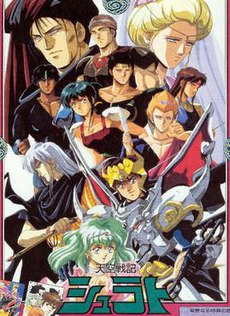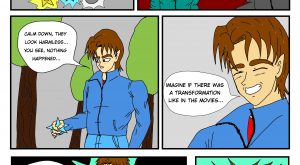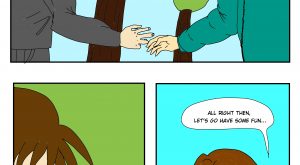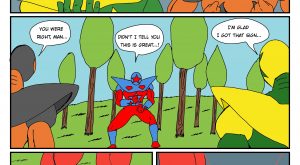Legend of Heavenly Sphere Shurato (manga)
Legend of Heavenly Sphere Shurato (Japanese: 天空戦記 シュラト, Hepburn: Tenkū Senki Shurato, lit. “Shurato of the Heaven Wars”, occasionally spelled in the Siddhaṃ script on the logo and related merchandise) is a Japanese manga created, written and illustrated by Hiroshi Kawamoto and later adapted to anime by Tatsunoko Productions. It ran 38 episodes on TV Tokyo from April 6, 1989 to January 18, 1990 and also received a 6-episode OVA followup series named Shurato: Dark Genesis (シュラト 創世への暗闘, Shurato Sōsei e no Antō, lit. “Shurato: The Secret Feud of Creation”), that ran from August 16, 1991 to March 16, 1992. It was one of the most popular shōnen anime series of 1989.[citation needed]
Set in a parallel world called “Tenkūkai”, which exists alongside Earth, evil forces known as the Asura Gods threaten to overcome the forces of good, causing the magical leader of this realm to transport warriors from Earth to their world. It was heavily based on Hindu and Buddhist mythology, and covered a range of topics, including brotherhood, reincarnation, camaraderie, interdimensional travel, destiny, and spiritual energy.
Plot
The plot revolves around two boys, Shurato Hidaka and Gai Kuroki, lifelong best friends who are polar opposites of each other in appearance and personality. While fighting each other in a martial arts tournament, they are suddenly encased in a beam of light and transported to a parallel world, Tenkūkai, where modern technology does not exist and instead the people rely on Sohma, a form of spiritual energy.
Shurato discovers he is actually the reincarnation of an ancient king of the same name, who once ruled this world, and one of the “Hachibushu”, a group of eight legendary warriors with large quantities of Sohma, and was brought here along with Gai to fight the Asura Gods, a legion of destructive warriors. However, for unknown reasons, Gai attempts to kill Shurato repeatedly, confusing Shurato as the real Gai is a pacifist and the most compassionate person he knows.
Things quickly go wrong when Shurato and another of the Hachibushu, Ten-ō Hyūga, are framed for the petrification of Lady Vishnu, a powerful divinity and the leader of the people of Tenkūkai. The actual culprit, Vishnu’s highest advisor and Asura spy Indrah, and the corrupted Gai manage to convince the remainder of the Hachibushu, as well as all of Tenkūkai’s warriors and soldiers, that Shurato and Hyūga are evil and must be killed.
Although at first reluctant to get involved, Shurato eventually resolves to aid Hyūga in uncovering the conspiracy and cure Vishnu. They are accompanied by the young Tenkūkai spirit priestess Lakshu, and two others of the Hachibushu, Ryū-ō Ryōma and Karura-ō Reiga. Along the way, they engage in battle with the other four of the Hachibushu, sinister Asura agents in league with Indrah, and the majority of Tenkūkai’s population.
| Legend of Heavenly Sphere Shurato | |

Promotional image for Legend of Heavenly Sphere Shurato
|
|
| 天空戦記 シュラト (Tenkū Senki Shurato) |
|
|---|---|
| Genre | Action, fantasy, mythic |
| Manga | |
| Written by | Hiroshi Kawamoto |
| Published by | Shōnen Gahōsha |
| Magazine | Shōnen King |
| Demographic | Shōnen |
| Original run | January 1988 – May 1988 |
| Volumes | 2 |
| Anime television series | |
| Directed by | Mizuho Nishikubo |
| Produced by | Heita Ezu Michio Shimizu Masakatsu Kozuru Motoki Ueda |
| Written by | Mayori Sekijima Takao Koyama Toshiki Inoue |
| Music by | Hiroya Watanabe |
| Studio | Tatsunoko Productions |
| Original network | TV Tokyo |
| Original run | April 6, 1989 – January 18, 1990 |
| Episodes | 38 |
| Original video animation | |
| Shurato: Dark Genesis | |
| Directed by | Yoshihisa Matsumoto |
| Produced by | Ippei Kuri |
| Written by | Mayori Sekijima Mizuho Nishikubo Satoru Akahori |
| Music by | Hiroya Watanabe |
| Studio | Tatsunoko Productions |
| Released | August 16, 1991 – March 16, 1992 |
| Episodes | 6 |
| Novel series | |
| Written by | Satoru Akahori |
| Illustrated by | Matsuri Okada Sho Sawada |
| Published by | Enix Kadokawa Shoten |
| Imprint | Enix Bunko Kadokawa Sneaker Bunko |
| Original run | December 1989 – June 1991 |
| Volumes | 7 |
| Novel series | |
| Legend of Heavenly Sphere Shurato – Dark Genesis | |
| Written by | Mayori Sekijima |
| Illustrated by | Matsuri Okada |
| Published by | Enix |
| Imprint | Enix Bunko |
| Original run | November 1991 – March 1992 |
| Volumes | 2 |





